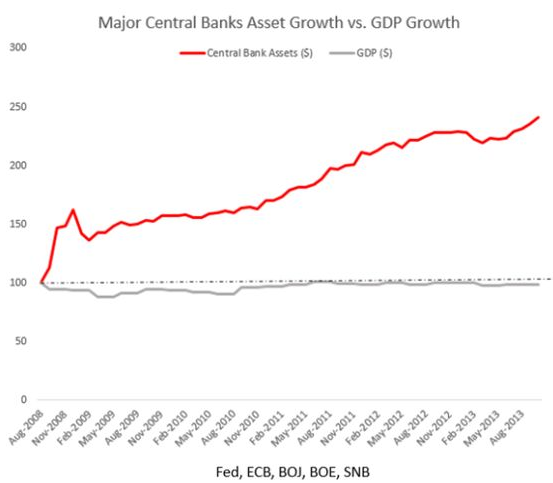(From Daniel Lacalle on Twitter)


His article last year "Are Central Banks Nationalising the Economy?" explains how the two charts are connected:
The government is not issuing “productive money” just a promise of higher revenues from higher taxes, higher prices or confiscation of wealth in the future. Money supply growth is a loan that government borrows but we, citizens, pay. The payment comes with the destruction of purchasing power and confiscation of wealth via devaluation and inflation. The “wealth effect” of stocks and bonds rising is inexistent for the vast majority of citizens, as more than 90% of average household wealth is in deposits.
In fact, massive monetization of debt is just a way of perpetuating and strengthening the crowding-out effect of the public sector over the private sector. It is a de facto nationalization. Because the central bank does not go “bankrupt,” it just transfers its financial imbalances to private banks, businesses, and families.
The central bank can “print” all the money it wants and the government benefits from it, but the ones that suffer financial repression are the rest. By generating subsequent financial crises through loose monetary policies and always being the main beneficiary of the boom, and the bust, the public sector comes out from these crises more powerful and more indebted, while the private sector suffers the crowding-out effect in crisis times, and the taxation and wealth confiscation effect in expansion times.
No wonder that government spending to GDP is now almost 40% in the OECD and rising, the tax burden is at all-time highs and public debt soars.
Monetization is a perfect system to nationalize the economy passing all the risks of excess spending and imbalances to taxpayers. And it always ends badly. Because two plus two does not equal twenty-two. As we tax the productive to perpetuate and subsidize the unproductive, the impact on purchasing power and wealth destruction is exponential.
To believe that this time will be different and governments will spend all that massive “very expensive free money” wisely is simply delusional. The government has all the incentives to overspend as its goal is to maximize budget and increase bureaucracy as means of power. It also has all the incentives to blame its mistakes on an external enemy. Governments always blame someone else for their mistakes. Who lowers rates from 10% to 1%? Governments and central banks. Who is blamed for taking “excessive risk” when it explodes? You and me. Who increases money supply, demands “credit flow,” and imposes financial repression because “savings are too high”? Governments and central banks.
Who is blamed when it explodes? Banks for “reckless lending” and “de-regulation”.
